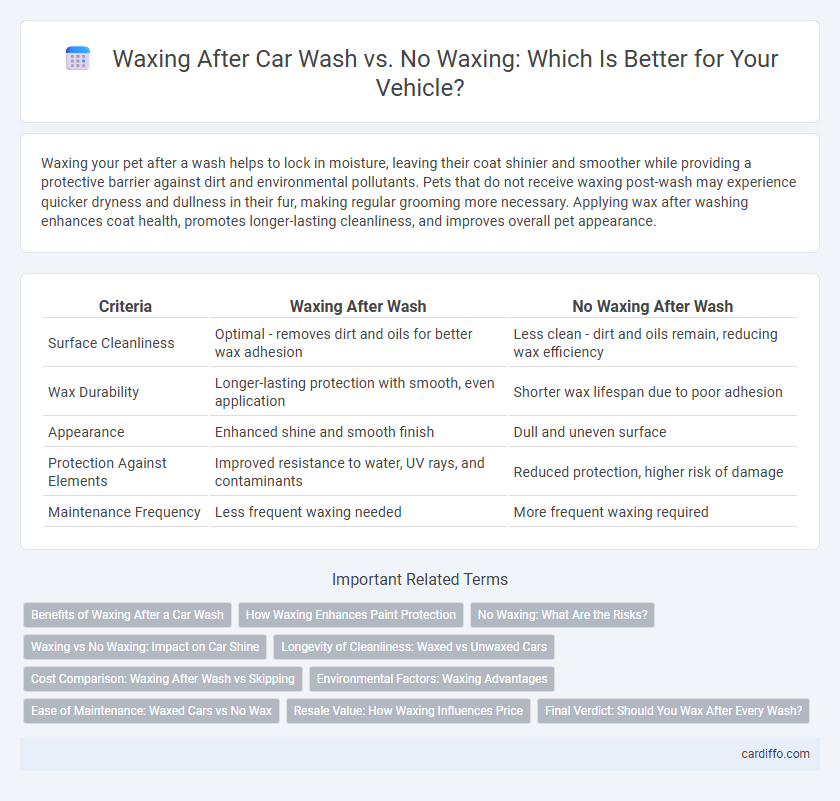Waxing your pet after a wash helps to lock in moisture, leaving their coat shinier and smoother while providing a protective barrier against dirt and environmental pollutants. Pets that do not receive waxing post-wash may experience quicker dryness and dullness in their fur, making regular grooming more necessary. Applying wax after washing enhances coat health, promotes longer-lasting cleanliness, and improves overall pet appearance.
Table of Comparison
| Criteria | Waxing After Wash | No Waxing After Wash |
|---|---|---|
| Surface Cleanliness | Optimal - removes dirt and oils for better wax adhesion | Less clean - dirt and oils remain, reducing wax efficiency |
| Wax Durability | Longer-lasting protection with smooth, even application | Shorter wax lifespan due to poor adhesion |
| Appearance | Enhanced shine and smooth finish | Dull and uneven surface |
| Protection Against Elements | Improved resistance to water, UV rays, and contaminants | Reduced protection, higher risk of damage |
| Maintenance Frequency | Less frequent waxing needed | More frequent waxing required |
Benefits of Waxing After a Car Wash
Waxing after a car wash seals in cleanliness by creating a protective barrier over the freshly cleaned paint, enhancing shine and preventing dirt accumulation. It also helps to repel water and reduces the risk of water spots, preserving the vehicle's finish longer. This protective layer minimizes UV damage and oxidation, extending the lifespan of the paint.
How Waxing Enhances Paint Protection
Waxing after washing creates a protective barrier that shields the paint from environmental contaminants such as UV rays, dirt, and moisture, preventing oxidation and fading. This layer also enhances water beading, reducing water spots and making future cleaning easier. Without waxing, the paint is more vulnerable to damage and degradation, leading to a dull appearance and potential long-term paint deterioration.
No Waxing: What Are the Risks?
Skipping waxing after a wash can leave your hair and skin vulnerable to rapid re-accumulation of dirt, oils, and dead skin cells, increasing the risk of clogged pores and breakouts. Without waxing, exfoliation is limited, which may result in ingrown hairs and uneven skin texture due to stubborn hair regrowth. Neglecting waxing post-wash can also reduce the removal of bacteria that cause skin irritation, potentially leading to inflammation and discomfort.
Waxing vs No Waxing: Impact on Car Shine
Waxing after washing a car significantly enhances the vehicle's shine by creating a protective layer that repels water, dirt, and UV rays, preserving the paint's vibrancy and reducing oxidation. Cars that are not waxed after washing tend to lose their glossy finish more quickly, as the bare paint surface is more susceptible to environmental damage and contaminants. Regular waxing maintains a deep, reflective shine and extends the longevity of the car's exterior appearance.
Longevity of Cleanliness: Waxed vs Unwaxed Cars
Waxing a car after washing creates a protective barrier that repels dirt and water, significantly extending the cleanliness and shine compared to unwaxed vehicles. The wax seal reduces the adherence of contaminants, allowing the car to stay cleaner for longer periods and making subsequent washes easier. Unwaxed cars tend to accumulate grime faster and lose their polished appearance more quickly.
Cost Comparison: Waxing After Wash vs Skipping
Waxing after a wash typically increases overall grooming costs due to the added product and service expenses, averaging $40 to $70 per session compared to the zero cost of skipping waxing. Not waxing after washing reduces immediate out-of-pocket expenses but may lead to higher long-term costs for skin care and hair management products. Investing in waxing post-wash can offer a cost-effective balance by extending smoothness duration and reducing the frequency of washes.
Environmental Factors: Waxing Advantages
Waxing after a wash helps remove water and contaminants from the car's surface, allowing the wax to bond more effectively and provide a stronger protective barrier against environmental factors like UV rays, acid rain, and pollutants. This enhanced layer of protection reduces paint oxidation and fading, preserving the vehicle's finish for longer periods. Without waxing post-wash, the car remains more vulnerable to damage from dirt, dust, and environmental contaminants, accelerating wear and tear.
Ease of Maintenance: Waxed Cars vs No Wax
Waxing a car after washing creates a protective layer that repels dirt and water, significantly reducing the frequency and effort needed for subsequent cleanings. Without waxing, dirt adheres more easily to the surface, leading to faster buildup of grime and more frequent washes. Regular waxing not only enhances shine but also simplifies maintenance by making the wash process smoother and less time-consuming.
Resale Value: How Waxing Influences Price
Waxing after a wash creates a protective barrier that preserves the vehicle's paint, reducing oxidation and surface damage while enhancing gloss, which significantly boosts resale value. Cars maintained with consistent waxing retain a showroom shine longer, translating into higher market demand and better price offers from buyers. Neglecting waxing after washing can lead to faster paint deterioration, diminishing the vehicle's appeal and lowering its resale price.
Final Verdict: Should You Wax After Every Wash?
Waxing after every wash enhances the longevity and protection of your vehicle's paint by sealing in cleanliness and repelling contaminants. Skipping waxing post-wash can lead to quicker deterioration from environmental factors like UV rays, dirt, and moisture. For optimal maintenance, applying wax consistently after each wash is recommended to preserve the shine and safeguard the finish.
Waxing After Wash vs No Waxing Infographic

 cardiffo.com
cardiffo.com